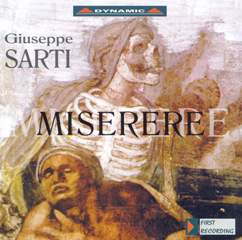Sarti - Miserere in F Minor (2000)
Sarti - Miserere in F Minor (2000)

1.Miserere Mei Deus (S, C, T, B, Chorus) -- Adagio 5:59 2.Amplius Lava Me (S, C, B) -- Affettuoso 2:27 3.Tibi Soli Peccavi (T, Chorus) -- Largo 4:23 4.Ecce Enim In Iniquitatibus (Chorus) -- Moderato 4:08 5.Ecce Enim Veritatem (B) -- Adagio 6:49 6.Asperges Me Hyssopo (S) -- Adagio 1:16 7.Auditui Meo (S) -- Largo 3:32 8.Averte Faciem Tuam (Chorus) -- Adagio 1:34 9.Cor Mundum Crea In Me (C) -- Larghetto 5:21 10.Ne Projicias (Chorus) -- Maestoso 1:50 11.Redde Mihi Laetitiam (S) --Allegro Spiritoso 4:26 12.Libera Me De Sanguinibus (S, C, T, B) -- Andantino 4:50 13.Sacrificium Deo (C) -- Adagio 7:41 14.Benigne Fac Domine (S, C, T, B, Chorus) -- Andante, Allegro Moderato 3:18 Tamiko Okada (soprano), Irene Olavide (alto), Victor Micaleff (tenor), Alberto Bianchi (bass) Faenza Lauda Sion Chorus, Ferrara Gianfranco Placci - director
One of the most interesting figures in the history of pre-romantic Russian music is Italian composer Giuseppe Sarti. Sarti arrived in St. Petersburg in 1784 at the request of Catherine the Great and stayed until the turn of the century, dodging court intrigues and benefitting from the intervention of nobles well-disposed to him. Sarti's Te Deum to celebrate the taking of Okachov (sometimes called his "Russian Oratorio") is one of the grandest and most over-the-top sacred works of the eighteenth century, rivaling Haydn's The Creation in sheer scale and bombast, if not artistic quality. While earlier Sarti had enjoyed a prosperous career in greater Europe that included lengthy positions in Copenhagen, Venice, and Milan, it is in Russia where Sarti is best remembered and his works are heard most often.
This setting of the Miserere is not a Russian work but something Sarti composed in Venice in the mid-1760s. For that time, it is a rather conservative setting and may have been written for the Ospedale della Pietà -- Vivaldi's old stomping grounds -- where Sarti was serving as chorus master. It almost could pass for Vivaldi, given its highly florid vocal writing, certainly influenced by opera, but the Red Priest had been in the grave more than decades when it was composed. However, that didn't keep this work from being very popular; it was widely circulated in manuscript and appeared in an undated print -- probably unauthorized -- in Leipzig, and in a way it is a little surprising that this Melodiya effort is apparently the first recording of the work. Regretfully, it really isn't very well performed -- the string playing is underpowered and slack, the continuo isn't together, and some of the entrances of the choir seem a little off in spots. ---Uncle Dave Lewis, AllMusic Review
download (mp3 @320 kbs):
yandex mediafire ulozto gett bayfiles








